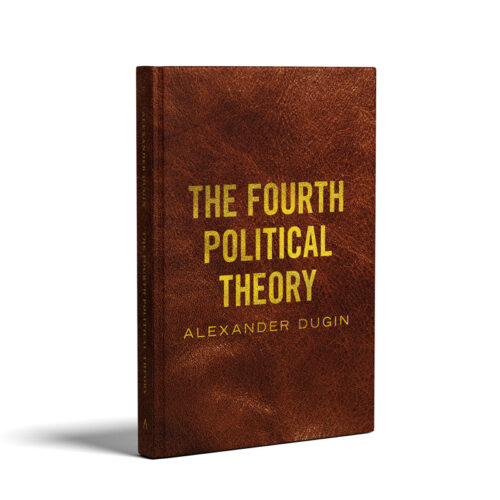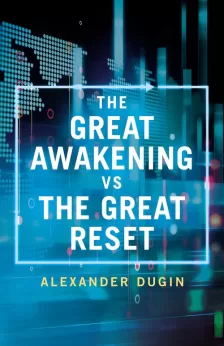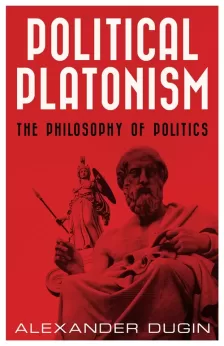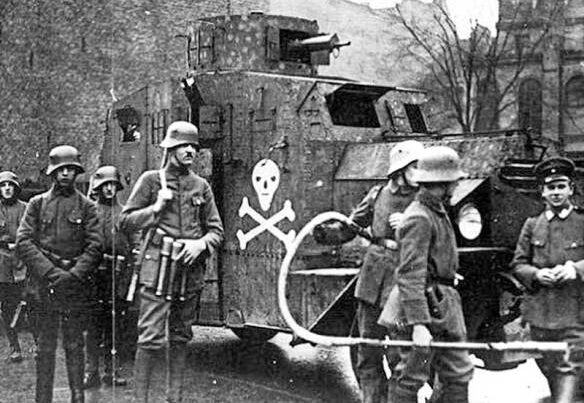War and belligerence lay in the foundation of the German Logos and psychology of the Germans, resulting in a special mentality and perception of the world, of surrounding tribes and nations.
Belligerence is a dominant strain of the Germans. Throughout their history, the Germanic societies, both continental and Scandinavian, were led by military men’s unions (Männerbünde), which incorporated representatives of the second estate, the martial function in the trifunctional hypothesis of Georges Dumézil. All European royal dynasties and houses are traced back to these unions, being founded by the Germans and, to a great extent, have survived as such. It is reflected in an allogeneic theory of origination of the states and elite; the Germanic military unions seized power over peoples, establishing their royal dynasties. The same story allegedly took place in Rus’, where the first dynasty was established by Rurik, who is said by some historians to be of Germanic origin.
War is a special element which precedes those who are in war, precedes enemies and reasons for war, and by no means sets or answers the question of who the victor is, does not point at or predetermine the victor. War comes first; it is in the middle, and all accompanying phenomena radiate as beams from it: poles of rivals, procuring the casus belli (in a name of what), preliminary preparations and warfare, battles, victors and vanquished. The Germans in their being are merged into this element as no one else, which is reflected on the level of myth in the cult of Odin, his maidens, the Valkyries, and Valhalla, and on the level of philosophy — to the greatest extent and based on the fundamental ontology — in Martin Heidegger’s teaching of the fourfold (das Geviert) of Seyn-Beyng. This belligerence of the Germans is explicitly implemented in their history up to the 20th century.
This understanding of war is in fine resonance with that of Heraclitus the Obscure:
πόλεμος πάντων μὲν πατήρ ἐστι, πάντων δὲ βασιλεύς, καὶ τοὺς μὲν θεοὺς ἔδειξε τοὺς δὲ ἀνθρώπους, τοὺς μὲν δούλους ἐποίησε τοὺς δὲ ἐλευθέρους.
War is father of all and king of all; and some he manifested as Gods, some as men; some he made slaves, some free.
Pre-Socratic Greek thinking begot the dictum which could have been agreed upon by the Germans, who have implemented it in the purest form, for it was the axis and the nerve of their tradition and world outlook. And such an agreement we witness in Heidegger’s thought.
The Greek god of war Ares is accompanied by Polemos — a daemon of war that embodies the element of battle, combat, that hovers amidst the warriors, blows of swords against shields, attacks and counterattacks, while Ares soars high over the battlefield. Polemos is a masculine deity, as is the German word Krieg and the Old Icelandic gunnr, denoting “war” and “battle”. The Russian for “war” is война, “voyna,” which is a feminine gender, as is брань, “bran’” — another term for the battle, wrangle. So the above cited translation of Heraclitus sounds erroneous to the Russian ear, as war must have been “mother of all.” The word polemos brings forth “polemics,” that is a controversy. The Russian “bran’” and other words originating from this stem bear the same meaning, though some of them downgraded to designate genre-styled quarrels of ordinary life.
Odin is also the god who instigates and abets conflicts and wars. But he, as Ares does, stays above the battlefield and the war; he is the god who is offered sacrifices [of enemies] and lives of warriors; who, being above the battlefield, grants one party the victory, often out of an arbitrary, capricious will; who carouses with them afterwards in the Hall of the Slain. The element of war — gunnr/Krieg/polemos — incorporates the Valkyries (the Old Icelandic valkyrjas), Odin’s maidens, who choose in the heat of the battle half of those who died to join the ranks of Odin’s forces (to become einherjar). Apart from the Valkyries, this special military female suite of Odin, the goddess Freyja, a member of the Vanir, receives the other half of the slain into her afterlife field Folkvangr. In the words Valhalla, Valkyrie, in some of the names of Odin and Freyja — Valfodr and Valamoder — father of the slain and mother of the slain, respectively, the first root stems from the Indo-European phoneme “*vl” — slain, dead, which evolves into the Old Icelandic valr, the Norwegian valen, the English “fallen.” The Valkyrie is “she who takes the fallen from the battlefield.” It is fair to say that Odin participates in the battle both directly, amidst blades and pole axes, and indirectly, through the Valkyries, who are right in the thick of things, attacks and deaths. Finding an affinity between the maiden-Valkyries and the Russian feminine “bran” is rather indirect and contextual and not etymological.
A resonance between Heraclitus’ insight “πόλεμος πάντων μὲν πατήρ ἐστι…” and Krieg’s implementation in the Germans, the Germanic Logos fits the pattern of the Hellenic-Germanic axis. A full-blooded war element, polemos–Krieg, we encounter in numerous Latin-Germanic wars of Rome against the Germanic tribes, described by historians, mostly of Greek origin. At that time, Odin acted as an absolute personification of the divine instigator of wars; he created and ruined unions, turned friends into foes, sowed hostility between the Germans and pitched them against the Romans and the Gauls. It was the time of the still living unrestrained element of pure belligerence, when war was the core, and the rest — who fights and with whom — were just derivatives built by war itself as its manifestations; they do not exist apart from war.
War is a prime element that emits-from-itself to the opposite directions the fronts, unions, rivals, the fallen and victors. And it manifests itself as fire. War is a fiery element. Fire is war.
Alviss, in his controversy with Thor, mentions the different names that fire has among people, the Titans and the gods:
Eldr ‘tis called by men,
but by the aesir funi;
the vanir call it vag,
say jotnar frekan,
but the dwarfs forbrenni;
in Hel they call it hraduth.
The difference in names suggests that fire is differently perceived in different worlds, by different beings, on different metaphysical levels, that it constitutes different beings. Among the Aesir it is heat, for funi is a derivate from fyr — flames. In the subtle world of the gods, fire is not material flames (which is the case with eldr — men’s “ordinary fire”), but a natural heat of frenzy and thirst for an active martial deed; it is the flame of excess. The opposite is a greedy devouring fire of a Titanic poverty of the Jotnar.
Fire is connected with war by numerous links-objectifications: war tools are forged in the fire of a furnace; in its heat the sword’s steel becomes firm and willing to kill, to bring death, victory and fame; war is carried on with fire — with torches, flaming arrows, conflagrations, grassland fires, arson, burning of villages and towns of the enemy; the heat of frenzy — is the fire of war in the bosom of the berserker or the warrior, his blood is hot, the temper is fiery; war is the space where the spirit blazes; finally, having found their death on the battlefield, the glorious warriors, Konungs and Jarls, are gone to the other worlds, Valhalla and Folkvangr, on a flaming bonfire or a long-ship, riding the flames which take them up to the sky. The myth introduces fire at the dawn of the universe, in the beginning of the cosmogenesis when icy Niflheim collided with fiery Muspelheim and sparks of this collision became proto-entities. The ruler of Muspelheim, the fiery Jotunn Surtr (Black), plays a crucial role in the eschatological battle on the Vigridr field, where he ends the battle of the gods and the thurs by stumping the cosmological tree Yggdrasil with his fiery sword, ending all nine worlds — engulfed in flames. Fire is the beginning and the end constituted by war.
For a German, according to his second caste of warriors, “to be” means “to-be-at-war” — in the moment of combat, an attack against the opposing enemy. Peace is the time for preparations for war; battle is the flash, a moment of being-here-and-now, a period of authenticity that lacks time (as time is sublated); “to be stands for to beat.” Let us introduce a nuance in understanding the fight, combat, battle which uncovers a fine distinction between the possible authenticity and non-authenticity of Dasein on the battlefield. A warrior may advance to face his enemy in two different ways. First is to don one’s best war gear, chain mail, guards, noble helmet, to take the sword adorned with gold, mount a stately warhorse, surround oneself with an equally noble and impressive suite, ensigns, flags, and command to blow into horns and beat the drums. Second is to face the enemy bare, smeared with soot or ash, intoxicated with substances, or in a frenzy without any external impact, with only a simple and reliable sword and a wooden shield.
The first is the konung, jarl, king as an embodiment of the will to power, who shares some of his status with things (a personalized sword, ensign, decorated horse) and delegates it to the suite (noble clans, sons, vassals). The heat of belligerence here is abated by the beauty of representation of might (Macht) through surrounding people and things, for such beauty demands ipso facto power and will to not let it go, to keep it by the lord. At the same time it does not mean that such a warrior lacks valour, courage, the knowledge of martial art, the skill and the nobleness of prosecution of war. But this environment of luxury, of things and men, already dissembles a distance and alienation from the element of war, the conversion of its flames into the lustre of dress, of gold, of fame. This is the path of the warrior of the Right Hand.
The second path is the one of the warrior whose nature is closer to the element of war, frenzied and in divine possession of the As Odin. He is perfectly indifferent to the material store and property he might or might not have. He enters the battle as if he were already dead, non-present as a person, but only a warrior for the sake of the battle here-and-now, during which he blazes up with an authentic mode of being. Vivid examples of such warriors are berserkers and ulfhednar (wolf warriors) and mythical einherjars, who spend their days fighting each other. De-personalization of such a warrior is conducted not only through de-identification with material attributes (getting bare-chested, smearing with dirt and ash, intoxication), but sometimes through possession by a beast’s spirit — the one of a bear or wolf, which he had to overcome during the initiation and gaining aegis of this beast as a martial totem. For such a warrior, the battle-and- death is the life-here-and-now. While life and death here are correctly understood not through dialectics of thesis and antithesis which are sublated in the synthesis of transfer “through death to a new life.” On the contrary, life and death must be comprehended literally as simultaneous, synchronous, as the same one action indeed, in the spirit of Zen-koan that breaks conventional and customary logic (generally speaking, it should be renounced altogether, when it comes to myth and the question of beyng). Only when openly going to his doom is the warrior living a fully authentic life. During a truce, a warrior lives a life “borrowed” from death and the battle to be. This is the path of the warrior of the Left Hand.










Being “warlike and belligerent” isn’t a “Germanic trait” anymore than it is a trait of all pre-state societies. Look at the tribal peoples of Papua, American urban street gangs or migrant youth in Sweden.
Those who reject the authority of the state love nothing more than constantly killing each other and this is a basic human trait more so than a “Germanic” trait. I am more inclined to respect the embrace of Western Civilization by the former Germanic tribal peoples than their previous savage state.
Storm of Steel vibes